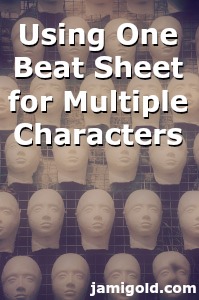One of my most popular posts is for my Romance Beat Sheet, but one of my readers asked if I could create a Scrivener template to go along with the Romance Beat Sheet. Yes! If you’re a romance author and use Scrivener for drafting your stories, today’s post is for you.
Pin It
Read More
When it comes to learning about point of view and how to avoid issues like head-hopping, it doesn’t help that half the information out there is confusing and contradictory. Let’s take a closer look at how we can find and fix these issues.
Pin It
Read More
Stories with multiple major characters—with their own point-of-view (POV) scenes—can make story structure complicated. Do we have to make beat sheets for each character? As a romance author, I write with multiple POVs all the time, so let’s see if we can figure out how to make beat sheets work in those situations.
Pin It
Read More
Most stories open with the protagonist on page one, but every once in a while, our story seems to work best if we start with another character. If we understand why the protagonist usually works best as the point-of-view character for the first page, we might be able to remake those exceptions into stronger openings.
Pin It
Read More
One of my commenters asked a great question last week that gets to the heart of the balancing game we have to play when writing romance. The characters have to be perfect enough for each other to make a believable couple, but there also has to be enough conflict between them to sustain a story.
Pin It
Read More
As soon as immersion is broken for a reader, their suspension of disbelief is at risk, so we don’t want unbelievable aspects of our story to kick readers out of the story midway. When it comes to believability, issues could crop up within the plot, characters, or worldbuilding, and we have to find the right balance within each of those areas.
Pin It
Read More
How we describe characters often depends on our story’s genre and what impression we want readers to have. When we’ve talked about descriptions here before, we focused on how it’s important to describe our settings enough to anchor our readers. Do we have to describe our characters to the same extent?
Pin It
Read More
Today’s Question: “How does one figure out which POVs to use and when? … How can I balance it out so that each character has their share of the novel without revealing too much or ruining the suspense?”
Pin It
Read More
Kim wants to know if there’s an optimal number of characters to include in a novel. That’s a great question because we want to hit the balance between the claustrophobia of too few characters and the confusion of too many characters.
Pin It
Read More
I’m a big fan of Michael Hauge’s approach to characters. His insights helped me figure out how to match a character’s internal journey to the external plot. This is often tricky, though, so let’s go deeper into how characters change.
Pin It
Read More










